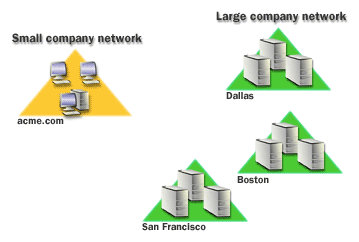| Lesson 4 | Define domain controllers. |
| Objective | Functions of a Domain Controller in Active Directory |
Functions of Domain Controller in Active Directory
A domain controller on a Windows based system is a server that stores an Active Directory partition or copy of the directory.
A domain controller has several important functions:
A domain controller in Active Directory (AD) plays a crucial role in managing network security, user access, and directory services within a Windows domain. Here are the primary functions of a domain controller in Active Directory:
By performing these functions, domain controllers ensure the security, reliability, and efficiency of network operations within an Active Directory environment, providing a robust framework for managing users, computers, and other resources.
A domain controller has several important functions:
- It manages the changes to directory information.
- It copies directory changes to other domain controllers in the same domain.
- It stores directory data.
- It manages user logon processes, authentication, and directory searches.
A domain controller in Active Directory (AD) plays a crucial role in managing network security, user access, and directory services within a Windows domain. Here are the primary functions of a domain controller in Active Directory:
- Authentication and Authorization:
- User Authentication: Validates user credentials (username and password) to allow access to the network.
- Authorization: Determines what resources a user can access and what actions they can perform based on their permissions and group memberships.
- Centralized Management:
- User and Group Management: Manages user accounts, groups, and organizational units (OUs) within the domain, allowing administrators to create, modify, and delete these entities.
- Policy Enforcement: Implements Group Policy Objects (GPOs) to enforce security settings and other configurations across the domain, ensuring consistent policies and settings.
- Replication:
- Data Synchronization: Ensures that directory data is synchronized across all domain controllers within the domain and between domains in a forest. This replication helps maintain consistency and redundancy.
- Security:
- Kerberos Authentication: Uses the Kerberos protocol for secure authentication, enhancing security for user logins and resource access.
- Account Lockout Policies: Implements account lockout policies to protect against unauthorized access attempts and brute-force attacks.
- DNS Integration:
- Domain Name System (DNS): Integrates with DNS to translate domain names into IP addresses, facilitating the location of resources and services within the domain.
- LDAP Directory Services:
- Lightweight Directory Access Protocol (LDAP): Provides directory services using LDAP, allowing applications and services to query and interact with the directory information
- Resource Management:
- Service Publication: Publishes information about available services (such as printers and file shares) in the directory, making it easier for users to find and use network resources.
- Single Sign-On (SSO):
- Single Sign-On (SSO): Enables users to log in once and gain access to multiple resources and services without needing to re-enter credentials, improving user convenience and productivity.
- Schema Management:
- Schema Management: Manages the AD schema, which defines the structure of objects and attributes stored in the directory. This includes extending the schema to support new types of objects and attributes.
- Trust Relationships:
- Trust Management: Establishes and manages trust relationships between different domains within a forest or between different forests, allowing users to access resources across domain boundaries.
- Backup and Recovery:
- Data Protection: Facilitates backup and recovery of directory data, ensuring that critical information can be restored in case of data loss or corruption.
By performing these functions, domain controllers ensure the security, reliability, and efficiency of network operations within an Active Directory environment, providing a robust framework for managing users, computers, and other resources.
How many Domain Controllers your Network requires
A domain may have one or more domain controllers. As system administrator, you will need to address the issue of how many domain controllers you should you have in your domain. This will of course depend on the needs of your network.

Small Organization
A small organization that uses a single local area network (LAN) may need only one domain with two domain controllers to provide adequate availability and fault tolerance, whereas a large company with many geographical locations will need one or more domain controllers in each location to provide adequate availability and fault tolerance.
Whether you have one domain with a few domain controllers or a number of locations each with its own domain controller, availability and fault tolerance are ensured through multi-master replication.
Whether you have one domain with a few domain controllers or a number of locations each with its own domain controller, availability and fault tolerance are ensured through multi-master replication.
Mastering Active Directory
Active Directory and multi-master Replication
Active Directory uses multi-master replication, in which no single domain controller is the master domain controller.
Although all the domain controllers running Windows 2000 Server within a domain contain a writeable copy of the directory, domain controllers might hold different information for short periods of time until all the domain controllers have synchronized their changes to Active Directory. In the next lesson, we will define the different types of domain controllers and their role in Active Directory.
Allocating Domain Controllers - Exercise
Click the Exercise link below to complete an exercise on how to allocate the number of domain controllers properly.
Allocating Domain Controllers - Exercise
Allocating Domain Controllers - Exercise